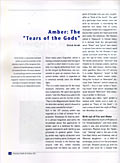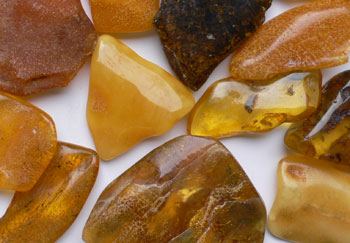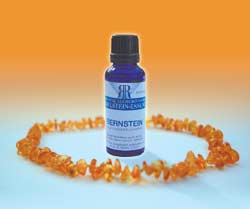|
||||||||
|
Alchemy & Paracelsus Medicine
Amber: The “Tears of the Gods”Since many years forgotten, amber is having a revival as jewel and fumigant – and for a short time it is also available in a liquid alchemical form: true to the recipes by Paracelsus, one succeeded to gain an essence from dissolved amber, which is regarded as a universal remedy since the Middle Ages.By Ulrich Arndt Birth out of Fire and Water Ovid described the myth of Phaeton in his “metamorphosis” and
from other poets it was also preserved in many variations. Phaeton
(engl. the “beaming”, “shining” one) is
the son of the Sun-God Helios and Klymene, one of Okeanos’ daughters – i.e.
a child of archetypal union of the fire and water principle. Phaeton
grows up with his mother and since he is teased because of his
unclear descent from children of the same age, he one day wants
to prove to everybody, that the Sun-God is really his father. He
persuades Helios, that he himself may drive the “sun-carriage” across
the sky for one day long. As Phaeton is not able to tame the horses
of the sun-carriage and the earth is already burnt for one half
by the sun, Jupiter flings him with a flash away from the carriage.
Phaeton falls into the river of the sky called Eridanus and drowns.
At its banks his sisters mourn for him. They freeze due to grief
and become trees. But their tears become amber – therefore
there is the epithet “Tears of the Gods” respectively
the ”Tears of the Daughters of the Sun“. Traditional Remedies The easiest application of amber is to wear it as jewellery in
direct contact to the skin. As a healing stone it was put on with
stomach, spleen, liver, gall-bladder and kidney complaints, and
with sufferings from stone diseases and nervousness. Thus for instance
duke Albrecht gave white amber to Martin Luther as a medicine against
his stone disease. While wearing amber, it supported moreover a “sunny
nature”, strengthened flexibility and creativity and helped
to keep traditional values in a positive way. Alchemical Processing “The practice for Carabe is as follows”, explains
Paracelsus the first simple preparation of an amber essence in
the sixth book of Archidoxis, “Take Carabe (= amber) well
pulverized. Then add Circulatum (= a solvent of alchemy; for first
experiments conditionally replaceable by high-proof alcohol) into
a bottle and leave it in ashes for six days. Then distillate it
as long as an oil is found at the bottom.” This oil can be
further processed for intake, what for one “circulates (the
oil with) wine spirits, for the essence itself becomes better and
the dissolving Menstruum stronger … The tincture has to be
golden-yellow … The dose of this essence is 20 to 30 drops.” Whereas
an essence prepared in such a way had an universal healing effect,
the processing with the help of vinegar chased away specifically
the perspiration and urine according to Johann Schröder, and
strengthened the heart. “Pour distilled vinegar on pulverized
white ‘Agstein’ (amber) … let it boil for several
days in the sand … until the distilled vinegar is becoming
red, filter and extract and repeat this three times, then precipitate
with the juice of lemons.” Therapists’ Experiences of Today
References
|
Für weitere Informationen beachten Sie auch die Partnerlinks
Bitte beachten Sie:
Die Informationen dieses webs sind journalistische Aufbereitungen des
jeweiligen Themas und ersetzen keine medizinische Beratung. Bei
gesundheitlichen Problemen und Erkrankungen suchen Sie bitte zuerst einen
Arzt oder Heilpraktiker auf. |
|
|
| |
Home |Impressum |Datenschutz | Links | Bücher
& Seminare | Suche | | Heilmittel | Alchemie | Diagnose | Therapien | Selbsthilfe & Ernährung | Spiritualität & Wissenschaft | Urwissen | Denken & Handeln | Freizeit | |
| © horusmedia.de Ulrich Arndt Rechtliche Hinweise |
|
Bitte beachten Sie: Die Informationen dieses webs sind journalistische Aufbereitungen des jeweiligen Themas und ersetzen keine medizinische Beratung. Bei gesundheitlichen Problemen und Erkrankungen suchen Sie bitte zuerst einen Arzt oder Heilpraktiker auf. Ausdrücklich sei zudem darauf hingewiesen, dass in Artikeln eventuell beschriebene Methoden, Therapien, Hilfsmittel und Nahrungsergänzungen lediglich Hinweise und Verfahren einer alternativen, esoterischen oder traditionellen Erfahrungs-Heilkunde darstellen und keine Heilmittel und anerkannte Therapieformen im Sinne der heutigen Schulmedizin sind. copyright - Urheberrecht Rechtliche Hinweise Die Urheberrechte sämtlicher Texte liegen, sofern nicht ausdrücklich anders gekennzeichnet, bei Ulrich Arndt (im Folgenden der Autor genannt). Inhalte dürfen nur zu Informationszwecken und nicht zum Verkauf oder zur Verbreitung zu gewerblichen oder politischen Zwecken verwendet werden. Kein Artikel, kein Auszug aus einem der Texte, keine Grafik oder Bild dürfen ohne schriftliche Zustimmung des Autors in irgendeiner Weise vervielfältigt, verbreitet oder öffentlich wiedergegeben werden. Ohne schriftliche Einwilligung des Autors dürfen die Datenbank oder Teile von ihr auch nicht in von Datenverarbeitungsanlagen verwendbare Sprachen übertragen oder übersetzt werden und dauerhaft gespeichert. Ausgenommen hiervon sind nur Vervielfältigungen, die technisch zum Zwecke des Einblicks in die Datenbank unumgänglich sind und nur vorübergehend vorgenommen werden. Die Urheberrechte an Bildern und Grafiken liegen manchmal beim Autor, manchmal bei den Zeitschriften, in denen die Artikel erschienen sind, oder bei Dritten. Jegliche Nutzung bedarf der schriftlichen Zustimmung des jeweiligen Rechteinhabers. Der Autor behält es sich ausdrücklich vor, Teile der Seiten oder das gesamte Angebot ohne gesonderte Ankündigung zu verändern, zu ergänzen, zu löschen oder die Veröffentlichung zeitweise oder endgültig einzustellen. Markenrecht Alle in Artikeln eventuell erwähnten Marken- und Warenzeichen unterliegen uneingeschränkt den Bestimmungen des jeweils gültigen Kennzeichenrechts und den Besitzrechten der jeweiligen Eigentümer. Verwendungen bedürfen der schriftlichen Zustimmung des Marken- und Rechteinhabers. Links Einige Seiten dieser Website enthalten Links zu externen Websites. Diese Links ermöglichen Ihnen den Zugang zu weiteren Informationen bestimmter Themen. Trotz sorgfältiger inhaltlicher Kontrolle zum Zeitpunkt der Verlinkung übernimmt der Autor keine Verantwortung und Haftung für die Inhalte externer Links. Für den Inhalt der verlinkten Seiten sind ausschließlich deren Betreiber verantwortlich. Haftungsausschluss Der Autor hat die Informationen der Artikel nach seinem Stand des Wissens zum Zeitpunkt der Entstehung des Artikels und mit journalistischen Sorgfalt erstellt. Sollten sich dennoch unvollständige, fehlerhafte oder illegale Informationen eingeschlichen haben, so bittet der Autor um Entschuldigung, übernimmt aber keinerlei Haftung. Mit den Artikeln dieser Website sind keine Angaben und keine Gewähr zur Eignung der darin enthaltenen Informationen für einen bestimmten Zweck verbunden. So übernimmt der Autor keine Gewährleistung und Haftung im Zusammenhang mit jeglicher Nutzung der Informationen auf dieser Homepage, und in keinem Fall kann er haftbar gemacht werden für besondere oder indirekte Schäden, Folgeschäden, entgangenem Gewinn oder sonstige Handlungen, die aus Nutzung der Informationen resultieren. Sofern Teile oder einzelne Formulierungen dieses Textes der geltenden Rechtslage nicht mehr oder nicht mehr vollständig entsprechen sollten, bleiben die übrigen Teile des Dokuments in ihrem Inhalt und ihrer Gültigkeit davon unberührt. |


 “This is a noble medicine for the head, stomach, intestines,
and other sinews complaints, the same also against stones.” Like
this Paracelsus adores the amber-essence and he further writes: “That
is the Magisterium Carabe (thus he describes amber), which showed
in many ways wonderful virtues.”
“This is a noble medicine for the head, stomach, intestines,
and other sinews complaints, the same also against stones.” Like
this Paracelsus adores the amber-essence and he further writes: “That
is the Magisterium Carabe (thus he describes amber), which showed
in many ways wonderful virtues.” Since
the beginning of 2005 therapists collect their first experiences
with the amber essence by Paracelsus, which is again available
now. According to their reports it has in fact an amazing intense,
purifying and balancing effect on the entire digestive apparatus
and on the respiratory tracts. The amber essence activates similar
to the gold essence at once several chakras and therefore is effecting
energetically in manifold ways. Especially stimulated are the solar
plexus, sexual, and root chakra, which are under the control of
the entire “digestion” and “incorporation”,
thus the energetic integration into one’s own self as well
as into the vital and sexual energies.
Since
the beginning of 2005 therapists collect their first experiences
with the amber essence by Paracelsus, which is again available
now. According to their reports it has in fact an amazing intense,
purifying and balancing effect on the entire digestive apparatus
and on the respiratory tracts. The amber essence activates similar
to the gold essence at once several chakras and therefore is effecting
energetically in manifold ways. Especially stimulated are the solar
plexus, sexual, and root chakra, which are under the control of
the entire “digestion” and “incorporation”,
thus the energetic integration into one’s own self as well
as into the vital and sexual energies.